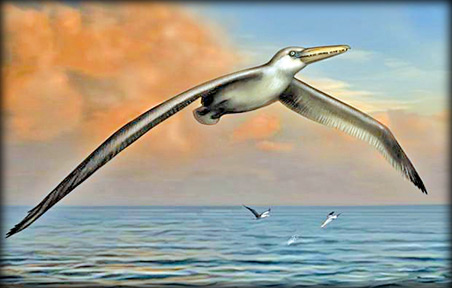Wingspan of the largest bird in history revealed
The bird, named Pelagornis sandersi, lived about 25 million or 28
million years ago
The largest flying bird in history had a 24 feet wingspan - more than
twice that of the biggest living albatross - and dined on fish probably
caught in mid-flight over the open ocean, a study has found. Fossilised
remains of the extinct species were first unearthed in 1983 during the
building excavations for a new terminal at Charleston airport in South
Carolina, but the latest analysis of the paper thin bones of its
skeleton revealed the giant wingspan, scientists said.
The bird, named Pelagornis sandersi, lived about 25 million or 28
million years ago. Its long, slender wings suggest that it could glide
for long periods with minimal energy, although its huge size suggests
that it may have had trouble taking off and landing without the help of
air currents or a downhill slope to run, they said.
|

An artistís impression of Pelagornis sandersi, which could
fly great distances |
Its wingspan would have been greater than the wingspans of the giant
condor and the royal albatross combined. Computer models of the wing
bones and flight feathers of living birds suggest that Pelagornis was a
very efficient glider capable of taking it out to sea for longer periods
of time without landing.
An array of small, tooth-like spikes in its upper and lower jaw means
that it is possible that the bird fed on fish, squid, eels and other
soft-bodied prey, probably caught while it was gliding over the ocean as
its large size indicates it was mathematically impossible to take off
from the sea surface simply by flapping is wings.
"Pelagornis sandersi could have travelled for extreme distances while
crossing ocean waters in search of prey.
That's important in the ocean where food is patchy," said Dan Ksepka,
curator of science at the Bruce Museum in Greenwich, Connecticut.
The bird's bony, teeth-like projections and other anatomical details
of its well preserved skeleton indicate that it belonged to the
Pelagornithidae: an extinct group of giant seabird that lived during
this period 25 million years ago, long after the dinosaurs had died out
but long before the rise of humans.
"Pelagornithids were like creatures out of a fantasy novel.
There is simply nothing like them around today....The upper wing bone
alone was longer than my arm," Dr Ksepka said.
Pelagornis may have lived much like modern day albatrosses, soaring
high into the sky and riding on air currents for long periods without
flapping their wings to preserve energy, occasionally swooping down to
the sea surface to feed on soft-bodied prey.
Pelagornithids were found all over the world and survived for tens of
millions of years before becoming extinct in the Pliocene about three
million years ago: their sudden disappearance remains a mystery.
- The Independent
|

